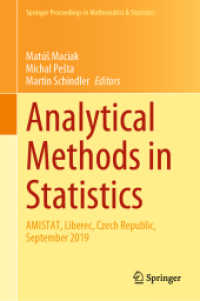- ホーム
- > 洋書
- > 英文書
- > Computer / Databases
Full Description
Learn everything you need to know to start using business analytics and integrating it throughout your organization. Business Analytics Principles, Concepts, and Applications brings together a complete, integrated package of knowledge for newcomers to the subject. The authors present an up-to-date view of what business analytics is, why it is so valuable, and most importantly, how it is used. They combine essential conceptual content with clear explanations of the tools, techniques, and methodologies actually used to implement modern business analytics initiatives.They offer a proven step-wise approach to designing an analytics program, and successfully integrating it into your organization, so it effectively provides intelligence for competitive advantage in decision making. Using step-by-step examples, the authors identify common challenges that can be addressed by business analytics, illustrate each type of analytics (descriptive, prescriptive, and predictive), and guide users in undertaking their own projects. Illustrating the real-world use of statistical, information systems, and management science methodologies, these examples help readers successfully apply the methods they are learning. Unlike most competitive guides, this text demonstrates the use of IBM's menu-based SPSS software, permitting instructors to spend less time teaching software and more time focusing on business analytics itself.A valuable resource for all beginning-to-intermediate-level business analysts and business analytics managers; for MBA/Masters' degree students in the field; and for advanced undergraduates majoring in statistics, applied mathematics, or engineering/operations research.
Contents
Preface xviPART I: WHAT ARE BUSINESS ANALYTICS 1Chapter 1: What Are Business Analytics? 31.1 Terminology 31.2 Business Analytics Process 71.3 Relationship of BA Process and Organization Decision-Making 101.4 Organization of This Book 12Summary 13Discussion Questions 13References 14PART II: WHY ARE BUSINESS ANALYTICS IMPORTANT 15Chapter 2: Why Are Business Analytics Important? 172.1 Introduction 172.2 Why BA Is Important: Providing Answers to Questions 182.3 Why BA Is Important: Strategy for Competitive Advantage 202.4 Other Reasons Why BA Is Important 232.4.1 Applied Reasons Why BA Is Important 232.4.2 The Importance of BA with New Sources of Data 24Summary 26Discussion Questions 26References 26Chapter 3: What Resource Considerations Are Important toSupport Business Analytics? 293.1 Introduction 293.2 Business Analytics Personnel 303.3 Business Analytics Data 333.3.1 Categorizing Data 333.3.2 Data Issues 353.4 Business Analytics Technology 36Summary 41Discussion Questions 41References 42Chapter 4: How Do We Align Resources to Support Business Analytics within an Organization? 454.1 Organization Structures Aligning Business Analytics 454.1.1 Organization Structures 464.1.2 Teams 514.2 Management Issues 544.2.1 Establishing an Information Policy 544.2.2 Outsourcing Business Analytics 554.2.3 Ensuring Data Quality 564.2.4 Measuring Business Analytics Contribution 584.2.5 Managing Change 58Summary 60Discussion Questions 61References . 61Chapter 5: What Are Descriptive Analytics? 635.1 Introduction 635.2 Visualizing and Exploring Data 645.3 Descriptive Statistics 675.4 Sampling and Estimation 725.4.1 Sampling Methods 735.4.2 Sampling Estimation 765.5 Introduction to Probability Distributions 785.6 Marketing/Planning Case Study Example: Descriptive Analytics Step in the BA Process 805.6.1 Case Study Background 815.6.2 Descriptive Analytics Analysis 82Summary 91Discussion Questions 91Problems 92Chapter 6: What Are Predictive Analytics 936.1 Introduction 936.2 Predictive Modeling 946.2.1 Logic-Driven Models 946.2.2 Data-Driven Models 966.3 Data Mining 976.3.1 A Simple Illustration of Data Mining 986.3.2 Data Mining Methodologies 996.4 Continuation of Marketing/Planning Case Study Example: Prescriptive Analytics Step in the BA Process 1026.4.1 Case Study Background Review 1036.4.2 Predictive Analytics Analysis 104Summary 114Discussion Questions 115Problems 115References 117Chapter 7: What Are Prescriptive Analytics? 1197.1 Introduction 1197.2 Prescriptive Modeling 1207.3 Nonlinear Optimization 1227.4 Continuation of Marketing/Planning Case Study Example: Prescriptive Step in the BA Analysis 1297.4.1 Case Background Review 1297.4.2 Prescriptive Analysis 129Summary 134Addendum 134Discussion Questions 135Problems 135References .137Chapter 8: A Final Business Analytics Case Problem 1398.1 Introduction 1398.2 Case Study: Problem Background and Data 1408.3 Descriptive Analytics Analysis 1418.4 Predictive Analytics Analysis 1478.4.1 Developing the Forecasting Models 1478.4.2 Validating the Forecasting Models 1558.4.3 Resulting Warehouse Customer Demand Forecasts 1578.5 Prescriptive Analytics Analysis 1588.5.1 Selecting and Developing an Optimization Shipping Model 1588.5.2 Determining the Optimal Shipping Schedule 1598.5.3 Summary of BA Procedure for the Manufacturer 1618.5.4 Demonstrating Business Performance Improvement 162Summary 163Discussion Questions 164Problems 164PART IV: APPENDIXES 165Appendix A: Statistical Tools 167A.1 Introduction 167A.2 Counting 167A.3 Probability Concepts 171A.4 Probability Distributions 177A.5 Statistical Testing 193Appendix B: Linear Programming 201B.1 Introduction 201B.2 Types of Linear Programming Problems/Models 201B.3 Linear Programming Problem/Model Elements 202B.4 Linear Programming Problem/Model Formulation Procedure 207B.5 Computer-Based Solutions for Linear ProgrammingUsing the Simplex Method 217B.6 Linear Programming Complications 227B.7 Necessary Assumptions for Linear Programming Models 232B.8 Linear Programming Practice Problems 233Appendix C: Duality and Sensitivity Analysis in Linear Programming 241C.1 Introduction 241C.2 What Is Duality? 241C.3 Duality and Sensitivity Analysis Problems 243C.4 Determining the Economic Value of a Resource with Duality 258C.5 Duality Practice Problems 259Appendix D: Integer Programming 263D.1 Introduction 263D.2 Solving IP Problems/Models 264D.3 Solving Zero-One Programming Problems/Models 268D.4 Integer Programming Practice Problems 270Appendix E: Forecasting 271E.1 Introduction 271E.2 Types of Variation in Time Series Data 272E.3 Simple Regression Model 276E.4 Multiple Regression Models 281E.5 Simple Exponential Smoothing 284E.6 Smoothing Averages 286E.7 Fitting Models to Data 288E.8 How to Select Models and Parameters for Models 291E.9 Forecasting Practice Problems 292Appendix F: Simulation 295F.1 Introduction 295F.2 Types of Simulation 295F.3 Simulation Practice Problems 302Appendix G: Decision Theory 303G.1 Introduction 303G.2 Decision Theory Model Elements 304G.3 Types of Decision Environments 304G.4 Decision Theory Formulation 305G.5 Decision-Making Under Certainty 306G.6 Decision-Making Under Risk 307G.7 Decision-Making under Uncertainty 311G.8 Expected Value of Perfect Information 315G.9 Sequential Decisions and Decision Trees 317G.10 The Value of Imperfect Information: Bayes' Theorem 321G.11 Decision Theory Practice Problems 328Index 335








